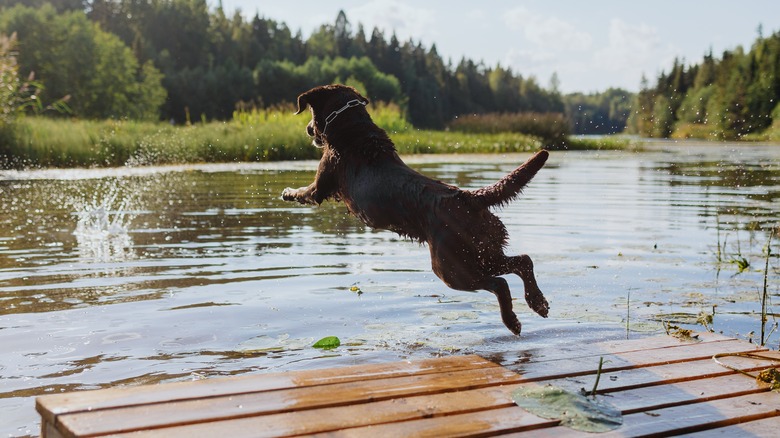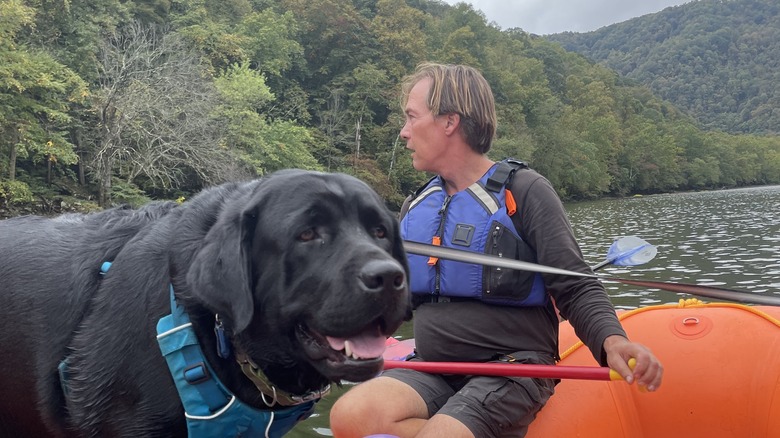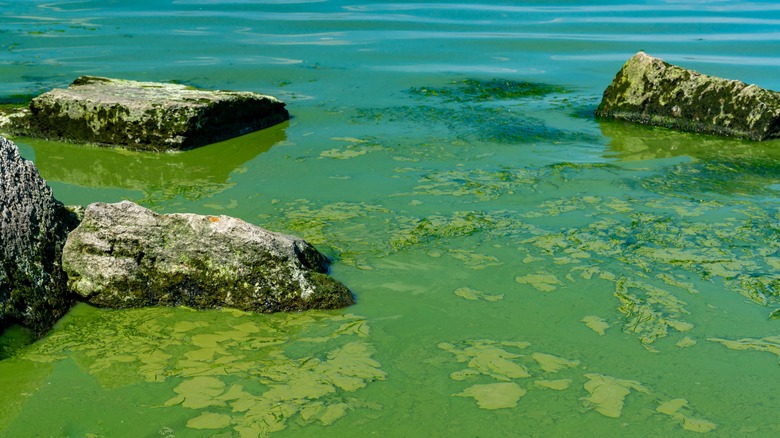Why You Need To Triple Check The Water On A Lakeside Vacation With Your Dog
The average dog only gets to experience about 10 to 13 summers in their lifetime. If that doesn't make you want to bring along your furry best friend for summer adventures, then consider that recent science has basically proven how much our canine companions care for us. The reason they wait joyfully by the door each time we return home is because they love us unconditionally, and spending time with us is the highlight of their day. Studies even show that many dogs are so attached to their humans that they experience separation anxiety when we're away. All that to say, you should totally bring your dog on vacation, and don't doubt for a second that they'll have the time of their life.
Traveling with your pet is easier than you might think. There are tons of popular campgrounds, hotels, and short-term vacation rentals that welcome pets, and some of the most beautiful state and national parks are dog-friendly. Lakes and rivers are particularly awesome summer vacations for you and your dog, with plenty of opportunities for splashes and smiles. While traveling with your fur baby is a blast, it's important to take proper precautions, especially if swimming is on the agenda. Your pet relies on you for their safety, and dangerous blue-green algae is a common problem you'll need to be aware of before you embark on your trip — especially if it involves swimming in lakes or rivers.
Check the water before swimming
During the summer, warm water temperatures in many natural bodies of water allow bacteria and algae to flourish. Most algae is totally harmless, but some can be lethal to both humans and dogs. Humans probably aren't ingesting a ton of lake water, but dogs don't know better and they can easily lap up toxic algae before anyone is able to stop them.
Blue-green algae is particularly dangerous to dogs, and is common throughout the United States during the summer. It's technically not algae, and instead is a cyanobacteria that produces neurotoxins. It's most commonly found in lakes, rivers, and ponds after the water temperature has consistently remained above 75 degrees. If blue-green algae is ingested, your dog can rapidly become very sick. Every single year, dogs across the United States are killed from ingesting blue-green algae. Symptoms may begin rapidly within 10 to 20 minutes after swimming, and can come on all at once or develop over several hours.
Signs to watch out for include vomiting, diarrhea, weakness, pale gums, drooling, tremors, paralysis, seizures, and even sudden death. By mid-summer 2024, several dogs had already passed away due to the harmful algae blooms. One dog owner shared a tearful warning on TikTok after her dog was poisoned while swimming in Lake Tahoe in July 2024. She said that there were no signs or warnings in place, and that the water looked clear. There is no cure for blue-green algae poisoning, but vets can attempt to intervene if you act quickly.
Testing for blue-green algae
Blue-green algae blooms are often said to resemble spilled green paint on the water's surface, or pea soup. It can also cause a gross odor that smells like decaying plants, or like septic — similar to the smell of a swamp. Sometimes, the blooms aren't blue or green in color at all. They can also appear to look like scum on the surface, and colors can range from turquoise to brownish red. To make matters even more challenging, sometimes the algae is present without any visible signs at all on the surface of the water. According to the Washington State Department of Health, "when in doubt, stay out!"
Some popular swim spots around the country do test for blue-green algae, but often only after an animal or person has become sick. You can try to detect if algae is harmful by filling a jar with the water and leaving it in your refrigerator overnight. If the algae settles at the top, it could be blue-green algae. Trying to grab the algae with a stick is another tactic: If it is stringy and able to be picked up, it likely isn't blue-green algae. However, if it looks like you dipped the stick in paint, it is probably the harmful kind. You can also purchase test kits online that claim to be 99% effective, which are helpful in ensuring you have a successful trip with your dog.


